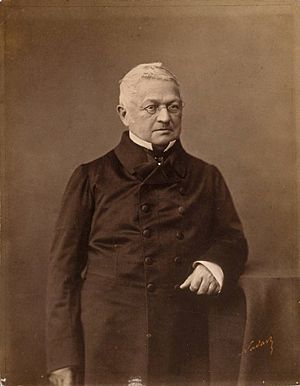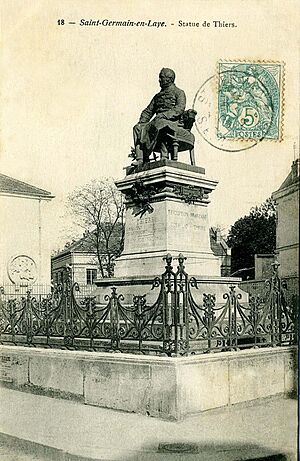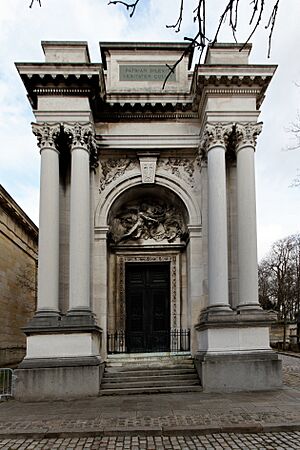Adolphe Thiers facts for kids
Quick facts for kids
Adolphe Thiers
|
|
|---|---|

Adolphe Thiers (1872)
|
|
| President of the French Republic | |
| In office 31 August 1871 – 24 May 1873 |
|
| Prime Minister | Jules Dufaure |
| Preceded by | Napoleon III (as emperor) |
| Succeeded by | Patrice MacMahon |
| Prime Minister of France | |
| In office 1 March 1840 – 29 October 1840 |
|
| Monarch | Louis Philippe I |
| Preceded by | Nicolas Jean de Dieu Soult, duc de Dalmatie |
| Succeeded by | Nicolas Jean de Dieu Soult, duc de Dalmatie |
| In office 22 February 1836 – 6 September 1836 |
|
| Monarch | Louis Philippe I |
| Preceded by | Achille Léonce Victor Charles, Duc de Broglie |
| Succeeded by | Louis, Comte Molé |
| Foreign Minister of France | |
| In office 1 March 1840 – 29 October 1840 |
|
| Monarch | Louis Philippe I |
| Preceded by | Nicolas Jean de Dieu Soult, duc de Dalmatie |
| Succeeded by | François Guizot |
| In office 22 February 1836 – 6 September 1836 |
|
| Monarch | Louis Philippe I |
| Preceded by | Achille Léonce Victor Charles, Duc de Broglie |
| Succeeded by | Louis, Comte Molé |
| Personal details | |
| Born |
Marie Joseph Louis Adolphe Thiers
15 April 1797 Bouc-Bel-Air, France |
| Died | 3 September 1877 (aged 80) Saint-Germain-en-Laye, France |
| Political party | Party of Resistance (1831–1836) Party of Movement (1836–1848) Party of Order (1848–1852) Third Party (1852–1870) Independent (1870–1873) Moderate Republican (1873–1877) |
| Signature |  |
Marie Joseph Louis Adolphe Thiers (April 15, 1797 – September 3, 1877) was an important French leader and historian. He became the second elected President of France. He was also the first President of the French Third Republic.
Thiers played a big part in two major French revolutions. The first was the July Revolution of 1830, which ended the rule of the Bourbon kings. The second was the French Revolution of 1848, which created the Second French Republic. He served as a prime minister several times. He also helped dedicate the famous Arc de Triomphe and brought Napoleon's ashes back to France from Saint-Helena.
At first, Thiers supported Louis-Napoléon Bonaparte. But later, he strongly disagreed with him. Louis-Napoléon became President and then Emperor Napoleon III. When Napoleon III took power, Thiers was arrested and sent out of France for a short time. He then came back and became a strong voice against the government.
After France lost the Franco-German War, which Thiers had opposed, he was chosen to lead the new French government. He helped negotiate the end of the war. In March 1871, a group called the Paris Commune took control of Paris. Thiers ordered the army to stop them. At 74 years old, he was named President of the Republic in August 1871. His biggest success as president was getting German soldiers to leave France two years earlier than planned. However, he faced opposition from different political groups and resigned in May 1873. Patrice de Mac-Mahon became the next President.
When Thiers died in 1877, his funeral was a huge event. Important republican leaders like Victor Hugo and Leon Gambetta led the procession. Thiers was also a well-known writer. He wrote a popular ten-volume history of the French Revolution. He also wrote a twenty-volume history about Napoleon Bonaparte's time as Consul and Emperor. In 1834, he became a member of the Académie Française, a famous French academy.
Adolphe Thiers' Place in History
People's opinions about Adolphe Thiers changed a lot depending on their own political views. Some people strongly criticized him. For example, Karl Marx, a famous thinker, had very harsh words for Thiers. He saw Thiers as someone who only cared about money and disliked working people.
Victor Hugo, a famous writer, first praised Thiers when Thiers helped him get into the Académie Française. But later, their relationship changed. Hugo wrote that he felt a mix of admiration, dislike, and disrespect for Thiers. Still, Hugo, along with Leon Gambetta, was present at Thiers' funeral.
Thiers even inspired a character in French literature. He was the model for Eugène de Rastignac in the famous La Comédie humaine series by Honoré de Balzac. Rastignac's journey from being poor to becoming successful in finance and politics was similar to Thiers' own life.
After Thiers died, writer Gustave Flaubert was impressed by the large crowds at his funeral. Flaubert wrote that even though he didn't always agree with Thiers, he saw him as a great leader. He believed Thiers had a strong love for his country, which made him special.
Later, after the student protests in Paris in May 1968, and during the time of President François Mitterrand in the 1980s and 1990s, Thiers' reputation became less positive. Some streets and metro stations in Paris were renamed after leaders of the Paris Commune. Historians on the left criticized Thiers for not focusing enough on social issues and for stopping the Commune.
However, historian Pierre Guiral wrote in 1986 that Thiers was like the "Washington of France." He called Thiers a patriot who founded the first French Republic that lasted. He also noted that Thiers helped remove Prussian soldiers from France. Guiral believed Thiers was a national figure who defended France from internal divisions.
Adolphe Thiers' Legacy

After Thiers' death, his home in Paris, the Hotel Thiers, became the headquarters of the Fondation Dosne-Thiers. This foundation is now part of the Institute of France. It holds his library, personal papers, and belongings. You can visit it if you get permission. The house also hosts classical music concerts.
Thiers was responsible for building Napoleon's tomb at Les Invalides. He also helped finish the column on Place Vendôme and the Arc de Triomphe, both of which he dedicated.
Thiers also oversaw the building of a ring of walls around Paris, known as the Thiers Wall. A few parts of this wall can still be seen today. The area where the wall once stood now marks the city limits of Paris.
A small street and a square in Paris are named after Thiers. There are also streets and squares named for him in other French cities like Bordeaux, Nancy, Tours, Fontainebleau, Melun, and his hometown, Aix-en-Provence. There is also a school called Lycée Thiers in Marseille. Some statues of Thiers in French towns were removed in the 1970s and 1980s.
Honors
- Legion of Honour (under Louis-Philippe):
- Knight: 1831
- Officer: 1833
- Commander: 1835
- Grand Officer: 1837
- Legion of Honour (Third Republic):
- Grand Cross: 1871, upon becoming president.
- Knight of the Order of the Golden Fleece of Spain (1871)
- Academie Française (1834)
- Foreign Honorary Member of the American Academy of Arts and Sciences (1875)
Images for kids
-
Prince Talleyrand, Thiers' political mentor, in 1828
-
Thiers asked Eugène Delacroix to decorate the ceiling of the library of the Palais Bourbon
-
Louis-Napoléon Bonaparte in 1848
-
Thiers, by Nadar
-
Adolphe Thiers photographed by Disdéri, around 1876
-
Portrait of Elise Thiers by Ingres (1834)
See also
 In Spanish: Adolphe Thiers para niños
In Spanish: Adolphe Thiers para niños
























